#velvet scoter
Text


velvet scoter (melanitta fusca) with a female common scoter (melanitta nigra), ireland
#anseriformes#anatidae#melanitta#velvet scoter#common scoter#display flight#ANOTHER LIFER TODAY!!!#wasn't even twitching i was just walking on the beach#noticed 400 scoters bobbing around on the water#and after a bit of looking i saw this pretty duck!!!!#actually so ridiculously happy#if i was capable of jumping and clicking my heels. brother you know i would be doing that!#TWO DUCK LIFERS WITHIN A COUPLE DAYS!!!#I LOVE DUCKS
4 notes
·
View notes
Photo




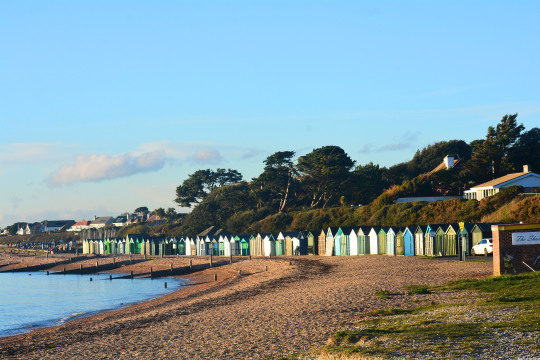

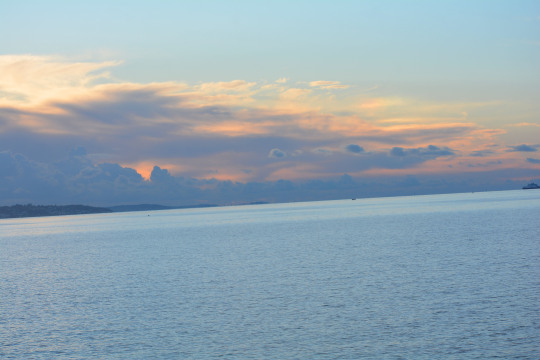

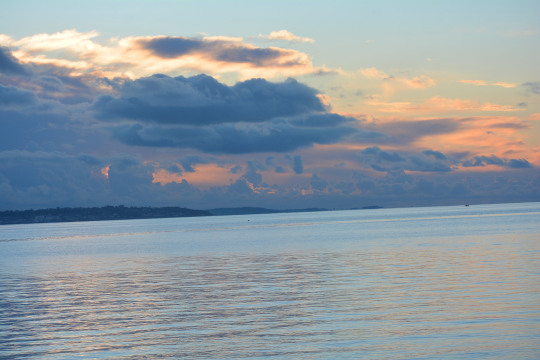

10/12/2022-Part 2 of 2: Lee-on-the-Solent
Following on from my previous post, we then today went to Lee-on-the-Solent near the Shack to look for the Velvet Scoters which had been around. We had a great time scanning through Common Scoters on the sea and managed to pick out a least a couple of Velvet Scoters. Our first of the year, a bird I do really admire and another wonderful species to add to my year list of late in a strong run I’m having as we get towards the end of the year that’s four weekends in a row I’ve got a year tick now. It’s my 205th bird of the year. Seeing both them and Common Scoters for the second time this year after some seen from Thornwick Bay in Yorkshire in June another of my birds of the year was a treat.
Also here we saw a fair few of one of my favourite birds the Great Crested Grebe on the water, a neat male Eider which was so lovely to see too, Cormorant, lots of Black-headed Gulls, bold Carrion Crows in the air and on the beach and delightful Pied Wagtails flitting around with a few flying down the beach towards dusk possibly coming into roost somewhere.
There were some excellent views of pristine and calm blue sea, immersive beach, dark green pine trees and fascinating cloud formations in the sweet winter sunlight here this afternoon. It was also lovely to watch the sun - that trickled a golden trail across the sea from the Isle of Wight which was lovely to see today too over to us as the second picture in this photoset shows - set and make the sky creamy and pink. There is something so stirring about a setting sun over the sea for me at any time of year I’ve had a good year for that this year and it’s a good atmosphere at this time of year with the sun setting on our walks. I liked seeing some leaves on the stoney beech too. I took the first and third-tenth pictures in this photoset of views and sky scenes here today. It was interesting to see people out enjoying themselves this afternoon including a couple braving the water on this cold day.
The journey to here and home was interesting with top and quirky views of an Oystercatcher by the road side and a Buzzard on a post. Coot, Mallard, Black-headed Gulls and Woodpigeon near and at a place we love Hill Head on the way back was nice to see, and there was something I’d never seen here; the water in Titchfield Haven and water by the Titchfield Canal that the road crosses frozen. It was funny we went past Titchfield Haven as like I’ve said before Titchfield Haven was the first nature reserve we ever visited in 2007 so it was an instrumental place in those early years of birdwatching for me and this brilliant reserve and great wild area is a key place for us. We first ever discovered it when I was just starting to get into birdwatching as we went to Lee-on-Solent quite a bit and we noticed the sign for Titchfield Haven on the way back once and checked out Hill Head seeing our first ever Turnstones before going into the reserve on a later date which I have fond memories of and was a key factor in starting it all for us to see birds. Sadly the visitor centre which is a key part of this site is under threat from closure and being sold off, and it’s sad to think of this useful space for the community and a key part of a reserve that inspires many to enjoy and protect nature is at risk. There is this petition: https://www.change.org/p/save-our-haven-centre against this which it was nice to see advertised here today.
It was nice to see the River Hamble looking pretty post sunset and some mist coming over the University of Southampton sports fields I believe on the way back and frost visible rather ending the day as it had begun. Today was a memorable winter day for me, part 1 of today’s posts about a frosty morning at Lakeside and home is here: https://dansnaturepictures.tumblr.com/post/703277251984277504/10122022-part-1-of-2-frosty-morning-at-lakeside
#photography#sea#nature#wildlife#velvet scoter#uk#world#happy#common scoter#eider#duck#ducks#eider duck#great crested grebe#water#beach#outdoors#outside#pied wagtail#buzzard#oystercatcher#carrion crow#birds#birdwatching#lee-on-solent#lee-on-the-solent#the shack#hampshire#england#walk
6 notes
·
View notes
Text
***Bird Stamps
Japan – 2022 Letter Writing Day – Birds
Japan – 2015 Japanese Crested Ibis
Japan – 2021 Letter Writing Day
Japan – 1992 Spotbill Duck
China – 2014 Birds of Prey: Hawk of the Gentiles
Finland – 2017 Long-tailed duck (clangula hyemalis)
Finland = 2027 Velvet Scoter (melanitta fusca)
Poland – 2023 Polish Post
Russia – 2018 Se-tenant: Green Woodpecker – Great Spotted Woodpecker
Niger – 1985…

View On WordPress
#asia#Bird#birds#birds of prey#black and white#china#duck#Finland#hawk#ibis#Japan#letter writing#Niger#peacock#poland#Russia#se-tenant#sparrow#three#velvet scoter#woodpecker
0 notes
Photo

A new variant has been added!
Velvet Scoter (Melanitta fusca)
© H. L. Meyer
It hatches from brown, coastal, dark, distinctive, large, much, northern, overall, small, subtle, top, white, woodland, and yellow eggs.
squawkoverflow - the ultimate bird collecting game
🥚 hatch ❤️ collect 🤝 connect
0 notes
Photo

Velvet Scoter, 1896, Norway.
56 notes
·
View notes
Text
i want to take a second to look at the velvet scoter’s eyeliner
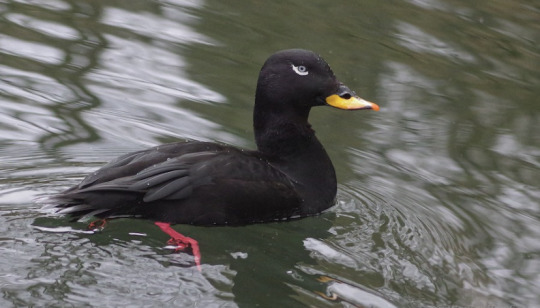

810 notes
·
View notes
Text
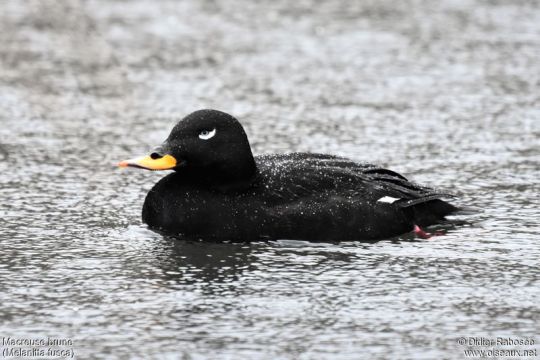
Velvet Scoter (Melanitta Fusca)
This duck is similar to, but larger than, its cousin the Common Scoter.
The Velvet Scoter favours coastal areas, though one may occasionally appear in a lake or reservoir
#velvet scoter#melanitta fusca#black duck#duck#bird#all black plumage#birds#black bird#black plumage#allblackbirds#black feathers#waterfowl
26 notes
·
View notes
Photo

#birds#watercolour#ink#bird#long tailed duck#duck#purple sandpiper#sandpiper#lesser whitethroat#whitethroat#european nightjar#nightjar#velvet scoter#scoter
77 notes
·
View notes
Photo
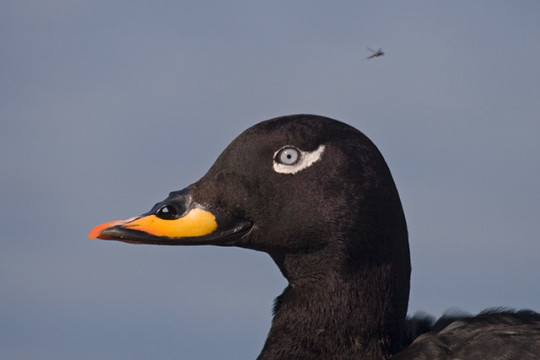




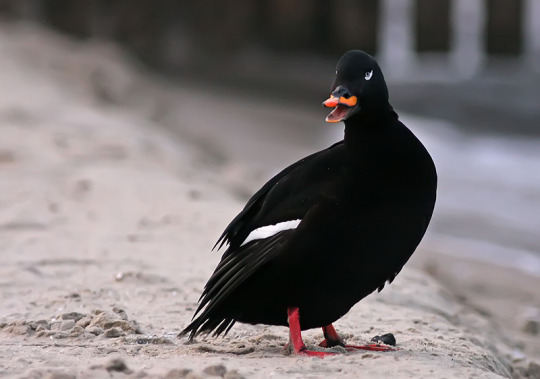

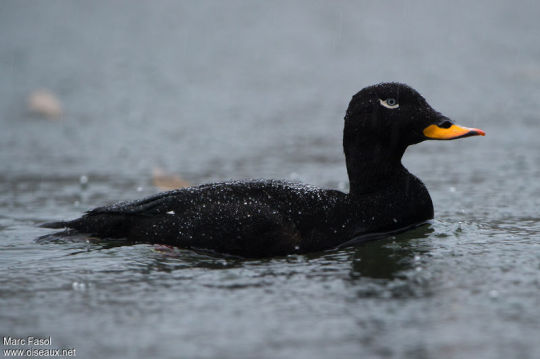
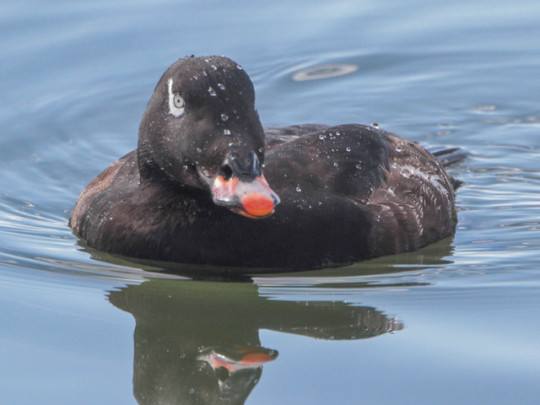
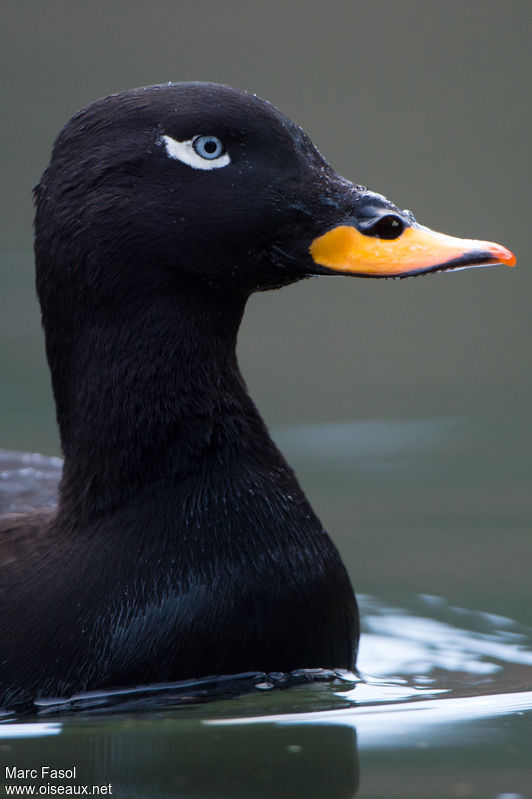
The velvet scoter (Melanitta fusca), also called a velvet duck, is a large sea duck, which breeds over the far north of Europe and Asia west of the Yenisey basin. The genus name is derived from Ancient Greek melas "black" and netta "duck". The species name is from the Latin fuscus "dusky brown".
Stejneger's scoter and the white-winged scoter are sometimes considered conspecific with the velvet scoter. Velvet, Stejneger's, and white-winged scoter, along with the surf scoter, are placed in the subgenus Melanitta, distinct from the subgenus Oidemia, black scoter and common scoters.
The velvet scoter is characterised by its bulky shape and large bill. It is the largest scoter at 20–23 inches. The male is all black, except for white around the eye and a white speculum. It has a bulbous yellow bill with a black base. The females are brown birds with two pale patches on each side of the head and white wing patches.
The lined nest is built on the ground close to the sea, lakes or rivers, in woodland or tundra, and typically contains 7–9 eggs. This duck dives for crustaceans and molluscs.
The velvet scoter winters farther south in temperate zones, Europe as far south as Great Britain, and on the Black and Caspian Sea. Small numbers reach France and northern Spain. It forms large flocks on suitable coastal waters. These are tightly packed, and the birds tend to take off together. The species is listed as Vulnerable by the IUCN.
318 notes
·
View notes
Text








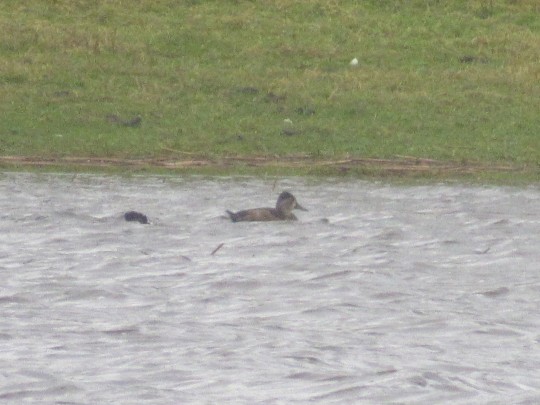

a selection of lifers i got for 2023! in order: forster's tern, whinchat, black-throated diver, twite, black-winged pratincole, little stint, european pied flycatcher, carrion crow x hooded crow hybrid, ring-necked duck and velvet scoter
lifers i didn't get photos of were the great shearwater, the grey phalarope and the western bonelli's warbler!
i also saw two birds that i've seen before in other countries, but last year i saw them in ireland for the first time: the cory's shearwater and the eurasian hoopoe
#birdwatching#birding#display flight#not tagging all of these guys with my tagging system. there's too many!!!#here's hoping 2024 will bring more good birds
1 note
·
View note
Photo


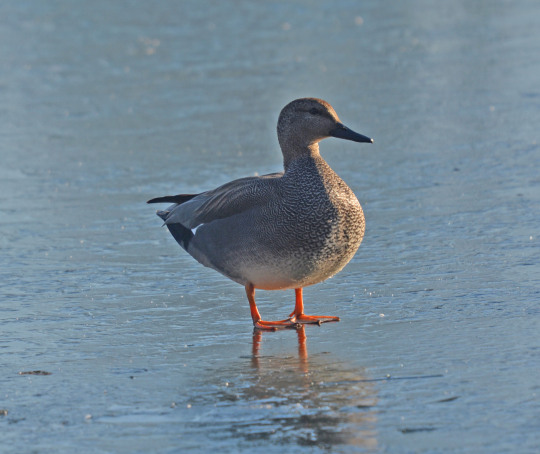

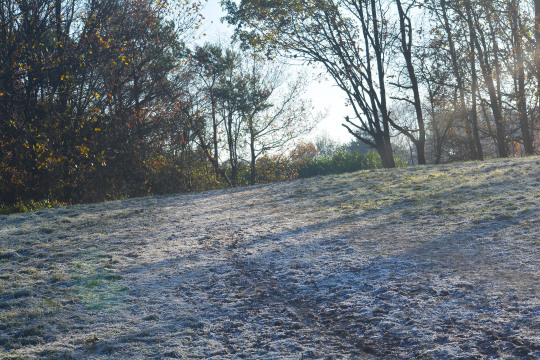
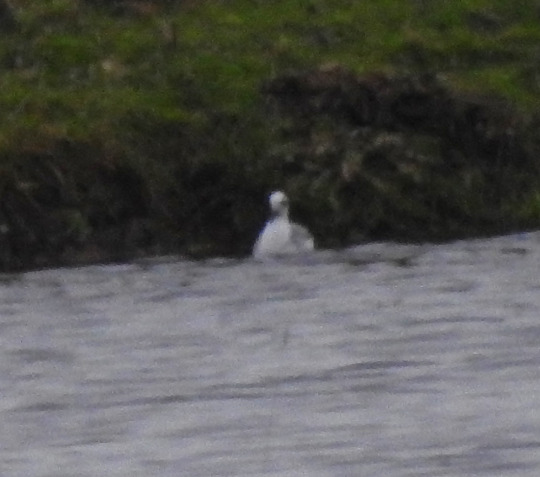




Ten standout moments/themes of my December and my birds of the month
Seeing two Short-eared Owls flying around near dusk at Farlington Marshes
A sensational moment of nature watching with a favourite species of mine which has been a key one to my year, one of my favourite ever birdwatching moments. I took the first picture in this photoset of a view there that day. I shared my bird of the month three ways this month; a consistent star, a one big standout moment and landmark moment for the year species and this species which narrowly missed out on being my first bird of the month in January is the big standout moment one.
Blog on the day: https://dansnaturepictures.tumblr.com/post/702739809365557248/41222-grey-phalarope-short-eared-owls-brent
Seeing my first ever American Wigeon at Pennington
A powerful moment for my whole year seeing a new bird and a very beautiful and alluring one in the rain at Pennington, and this is my landmark for the year bird of the month. I got the second picture in this photoset of gorse there that day.
The blog on the day: https://dansnaturepictures.tumblr.com/post/704009131175051264/18122022-american-wigeon-and-more-at-pennington
Two rarer ducks for Lakeside Country Park that turned up: Wigeon and Gadwall
I love when I see something not so uncommon elsewhere/generally but that is hardly ever found at my local Lakeside, winter is the time it happens most, and these two delightful duck species were thrilling to see and stood high in my standout patch and home moments of the year’s closing month. I took the third picture in this photoset of the Gadwall.
A blog at the time: https://dansnaturepictures.tumblr.com/post/702558456416288768/21222-lakeside-and-home-wigeon-kestrel-robin
Run of seeing Common Gulls
Mostly at Lakeside with the couple I enjoyed seeing there with sightings at coastal sites Hill Head and Calshot too I have had a brilliant run of seeing this species I really like in winter plumage multiple times, they are such beautiful and charming birds and this stood out this month so much so that it earned my consistent star bird of the month title. The fourth picture in this photoset shows one at Lakeside on the ice with Black-headed Gulls.
A blog at the time: https://dansnaturepictures.tumblr.com/post/703552871327727616/13122022-lakeside-and-home-it-was-good-to-see
Taking photos during the cold snap
One of my most memorable ever runs for seasonal photos in a winter over that time period as I enjoyed photographing generally and close up frost as the fifth picture in this photoset shows and ice gripping the landscape and birds on the latter, which felt a key period for my photography year.
A blog at the time: https://dansnaturepictures.tumblr.com/post/703277251984277504/10122022-part-1-of-2-frosty-morning-at-lakeside
Seeing Grey Phalarope that day at Farlington Marshes too
It was gratifying to see this merry bird flitting around a pool and add the species to my year list. I took the record shot the sixth picture in this photoset of it.
Blog on the day: https://dansnaturepictures.tumblr.com/post/702739809365557248/41222-grey-phalarope-short-eared-owls-brent
Velvet Scoter at Lee-on-Solent
Another star species of my year I really liked catching up with this month. I took the landscape in the seventh picture in this photoset there that day.
Blog on the day: https://dansnaturepictures.tumblr.com/post/703278941259120640/10122022-part-2-of-2-lee-on-the-solent
Run of seeing Great Spotted Woodpeckers
Another nice little sequence this month of seeing this exciting bird that I adore before and through the festive days at a few places. I took the eighth picture in this photoset of one at Lakeside during the run.
A daily blog mentioning this: https://dansnaturepictures.tumblr.com/post/704643396947656704/25122022-pig-bush-in-the-new-forest-and-bits-at
Siskins at Lakeside
A brilliant moment of patch birdwatching late on in the month with a group of this species I love seeing here, one of my favourite Lakeside moments this year very late in it. I took the ninth picture in this photoset of one.
Blog on the day: https://dansnaturepictures.tumblr.com/post/705099183032516608/30th-december-2022-lakeside-and-home-siskins-and
Flowers that I saw this month, notably red deadnettle, yarrow and gorse
Three recurring stars as I enjoyed seeing a few flowers still this month, with mercury, mustard and carrot seen nicely too and I also liked seeing berries and flower seed heads this month. I got the tenth and final picture in this photoset of yarrow in the flower bed area out the front.
A daily blog mentioning this:
https://dansnaturepictures.tumblr.com/post/704733021650239488/26122022-lakeside-and-home-part-2-of-2-flora
#december#2022#memories#reflections#birds#birdwatching#nature#photography#walking#wildlife watching#short-eared owl#grey phalarope#farlington marshes#american wigeon#wigeon#eurasian wigeon#gorse#gadwall#common gull#landscape#ice#frost#winter#lakeside country park#siskin#great spotted woodpecker#lee-on-solent#hill head#velvet scoter#red deadnettle
4 notes
·
View notes
Photo

ビロードキンクロ ♀
Melanitta stejnegeri Female




2019.12.06
千葉県千葉市
16 notes
·
View notes
Text
Melanitta
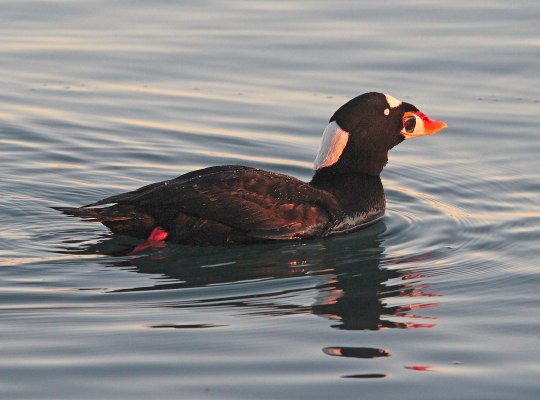
Surf Scoter by Alan Schmierer, in the Public Domain
PLEASE SUPPORT US ON PATREON. EACH and EVERY DONATION helps to keep this blog running! Any amount, even ONE DOLLAR is APPRECIATED! IF YOU ENJOY THIS CONTENT, please CONSIDER DONATING!
Name: Melanitta
Status: Extant
First Described: 1822
Described By: Boie
Classification: Dinosauria, Saurischia, Eusaurischia, Theropoda, Neotheropoda, Averostra, Tetanurae, Orionides, Avetheropoda, Coelurosauria, Tyrannoraptora, Maniraptoriformes, Maniraptora, Pennaraptora, Paraves, Eumaniraptora, Averaptora, Avialae, Euavialae, Avebrevicauda, Pygostylia, Ornithothoraces, Euornithes, Ornithuromorpha, Ornithurae, Neornithes, Neognathae, Galloanserae, Anseriformes, Anseres, Anatoidea, Anatidae, Merginae
Referred Species (all extant): M. americana (Black Scoter), M. nigra (Common Scoter), M. fusca (Velvet Scoter), M. deglandi (White-Winged Scoter), M. perspicillata (Surf Scoter)
Today’s dinosaurs are the Scoters, a group of fairly black seaducks with distinctive swollen bills (though all of the females are browner and more speckled in appearance). They form large flocks on the coasts, and actually take off together in these huge flocks. There are five living species, and for now, no extinct species are known.
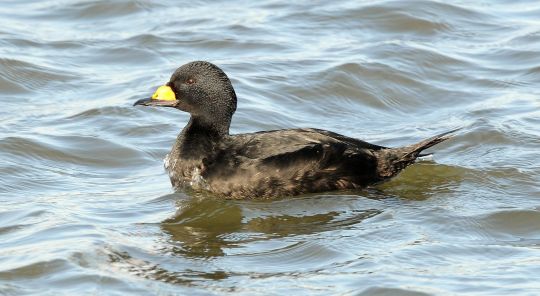
Black Scoter by Peter Massas, CC BY-SA 2.0
The Black Scoter, also known as the American Scoter, is a near-threatened large sea duck, weighing near 1 kilogram and found primarily in tundra of North America and easternmost Siberia. They not only have a bulky shape, but a very bulky bill with a yellow hump. They breed in the farthest north part of their range, and can be found further south in the winter, even spending the season as far south as the Great Lakes. They dive for crustaceans and molluscs on the sea coasts, though when they venture into freshwater they primarily feed on insects and larvae, as well as fish eggs and some plants. Their flocks are tightly packed on the coastal waters, though they are less social in the breeding season. They lay eggs close to the sea or in the tundra, with 5 to 7 eggs at a time, and only the females incubate the eggs. The young are flightless for about three weeks after hatching, during which time their mother protects them.
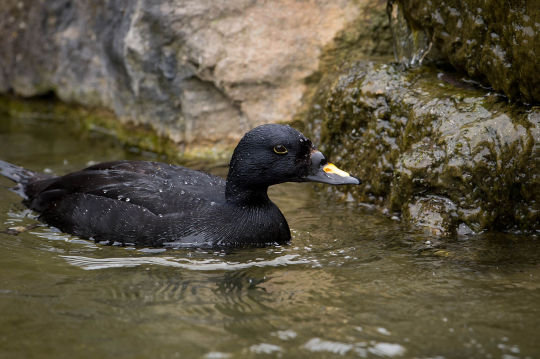
Common Scoter by Jason Thompson, CC BY 2.0
The Common Scoter is a non-threatened seaduck, bulky in shape with large lumpy bills. The bills are black with yellow patches. They live in Northern Europe and Asia, found in the tundra environment during the summer for the breeding season, and occasionally found as far south as Morocco during the winter. They form huge, tightly packed flocks on the coast that take off and dive together. The males have no white on their bodies, which makes them distinct from other Scoter species. They lay nests near the sea or in the tundra, and feed primarily on crustaceans and molluscs. Though not threatened with extinction, certain populations in the United Kingdom are on a sharp decline.

Velvet Scoter by Vince, CC BY 2.0
The Velvet Scoter is a threatened species, with smaller populations than the previous two species. They live during the winter in temperate Europe and Asia, and they nest in the far north, like other Scoters. They make nests on the ground close to the sea, where they dive for crustaceans and mollusks. They are bulky, with primarily yellow bills, and white patches on the wings, while the females are more brown. They are very rarely spotted in their range.
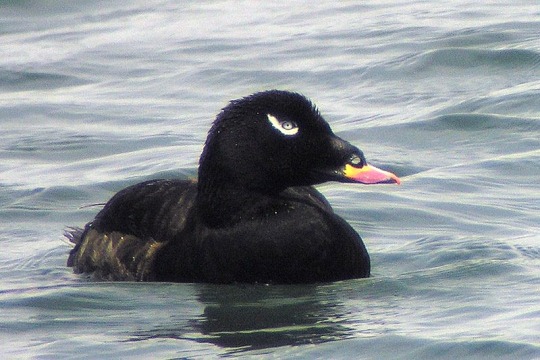
White-Winged Scoter by Lea Blumin, CC BY 2.0
The White-Winged Scoter is a non-threatened species, weighing nearly 2 kilograms in some cases, making them an extremely heavy species of Scoter - in fact, probably the heaviest of all. They breed in Western and Northern Canada and Alaska, and spend the winters along both the Atlantic and Pacific coasts, even sometimes far north along those coasts. To get to their winter range, they’ll even migrate and rest along the great lakes. They are very similar to the Velvet Scoter, but are currently considered to be a different species. They Are often found in Asia as well, even as far south as China. They form tightly packed flocks, which disband for the breeding season. They lay 5 to 11 eggs in a nest near the sea or lakes and rivers, and incubate them for a month. The females can be aggressive towards one another during the breeding season, and the young stay with the mother for about three weeks; and then together without the mom for another three weeks. Like other species in this genus, they feed on molluscs and crustaceans in the ocean, and insects and other crustaceans in freshwater.
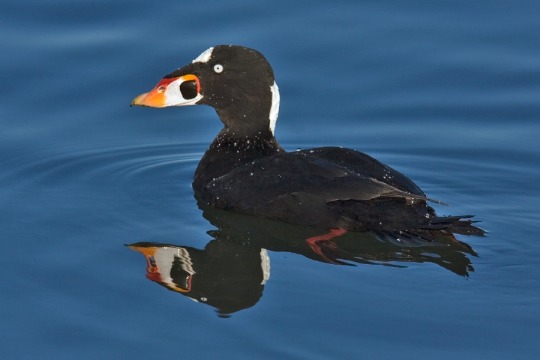
Surf Scoter by Alan D. Wilson, CC BY-SA 2.5
The Surf Scoter is the last species in the genus, and a rather large one, weighing up to 1 kilogram in the males. The males are a very velvety black except for its beak, which is distinctively patterned with red, orange, white, and black. Their white patches on their heads make them very visually distinct from other Scoters. The females, however, are mottled brown, and less visually distinctive. THey spend the breeding season in Northern Canada and Alaska, and winter along the coasts of both oceans, even as far south as Mexico and Texas. They breed in boreal forests near northern freshwater lacks, which is different than other species. They breed during the summer and females protect the nests on their own, and though the mothers take care of the young at first, they abandon the young before they are able to fly. The offspring congregate in small groups, before going to the wintering grounds on their own and joining up with the adults.

Surf Scoter by Alan D. Wilson, CC BY-SA 2.5
It feeds primarily on ocean invertebrates, and they’ll form small groups during the breeding season to eat a lot of different types of freshwater invertebrates, though their primary food is still ocean invertebrates, especially crustaceans and molluscs. They do shift their diet depending on food availability, indicating opportunism in the species - both in terms of what they eat and where they eat, often switching habitats to find more food. They will even capture food and eat it whole. They migrate over a variety of routes, usually with females and juveniles sticking together and the males in their own group. There are estimated to be up to a million of these birds throughout the world.
Buy the author a coffee: http://ko-fi.com/kulindadromeus
Sources:
https://en.wikipedia.org/wiki/Scoter
https://en.wikipedia.org/wiki/Black_scoter
https://en.wikipedia.org/wiki/Common_scoter
https://en.wikipedia.org/wiki/Velvet_scoter
https://en.wikipedia.org/wiki/White-winged_scoter
https://en.wikipedia.org/wiki/Surf_scoter
#melanitta#scoter#bird#dinosaur#duck#birblr#seaduck#black scoter#common scoter#velvet scoter#shite-winged scoter#surf scoter#melanitta americana#melanitta nigra#melanitta fusca#melanitta deglandi#melanitta perspicillata#dinosaurs#biology#a dinosaur a day#a-dinosaur-a-day#dinosaur of the day#dinosaur-of-the-day#science#nature#factfile#Dìneasar#דינוזאור#डायनासोर#ديناصور
40 notes
·
View notes
Photo


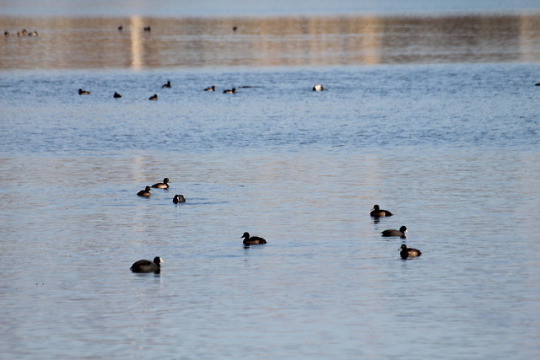

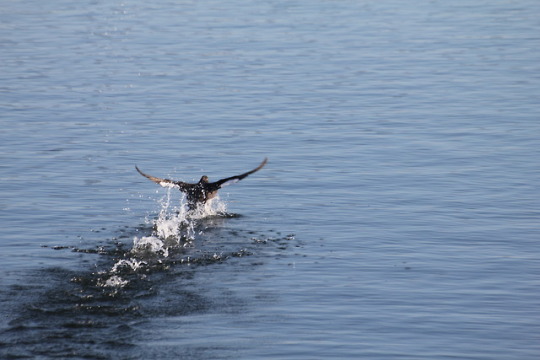
Kamionka Bolko [05.11.2018]
Velvet scoter/Uhla
#opole#bolko#wyspa bolko#kamionka bolko#nowa wieś królewska#pl#polska#poland#gdzie jest kisza#ptaki#birds#uhla#scoter#velvet scoter
7 notes
·
View notes
Photo

Velvet Scoters (Melanitta fusca) - photo by Daniel Stenberg
124 notes
·
View notes
Photo




To celebrate Halloween, I’m going to unveil a new OC every week for the rest of spooky month! First up, Agent Wolfduck! As usual, bio is below the cut and art is by @thefriendlyfour
Physical Description: A tall but svelt black velvet scoter duck (tall for a duck- around Morgana or Launchpad’s height) with a yellow beak, and long black head feathers that go down to his lower back and are typically kept in a loose dutch braid. While most of his feathers are black, the palms of his hands are white and he has one thin white stripe down the back of each arm and a curve of white feathers under each eye that looks almost like winged eyeliner.
As a werewolf, he also has two extra forms:
Partial transformation: Grows taller and buffer (a little larger than Steelbeak), eyes turn yellow, gains wolf ears, feathered tail turns into a fluffy black wolf one, and grows fangs & claws.
Full transformation: Becomes MUCH larger (close to Stegmutt in size), beak turns into classic wolf muzzle and turns black with sharp teeth, claws grow longer, webbed feet turn into clawed wolf feet, feathers change into thick fur, and eyes turn a more intense shade of golden yellow.
Outfit: As a lawyer, Wolfduck strives to look professional whenever he leaves the house. His usual suit is dark grey with a silver collar and waistband, as well as circular buttons painted to look like pale yellow crescent moons with black shadows. He usually pairs this with a white button-up shirt, black and silver belt under the suit jacket, and a pale yellow cravat with a special full-moon shaped tie-pin that waxes and wanes to show how much moonlight it has stored up. Also wears black spats instead of shoes (like Scrooge Mcduck) and very large, circular golden glasses.
Gender: Male
Sexual Orientation: Gay
Age: 39
Nicknames: Percy, Wolfy, Fang Face, Fangs Dog Breath, Puppy
Percy is his preferred nickname, but will tolerate Wolfy.
Others are all used by Steelbeak to annoy him.
Hates being called Puppy.
Real Name: Percival Dubois
Background:
Percival grew up as part of a werewolf pack with several littermates and elders, essentially being raised as part of a small, traveling communal family. They didn’t have much growing up due to their nomadic way of living, but they got by easily enough by taking what they needed through brute force.
He traveled across Europe with his pack as a child, making his way to America with them in his teen years by stowing away in a cargo ship.
Unfortunately, they all got busted when they came ashore and some of the pack’s elders got arrested so Percival and the others could escape. He was upset by this and asked the remaining elders when they’d get the others back, but they told him that they wouldn’t be able to- the legal system was frustrating and hard to navigate when you didn’t have enough money to pay for someone to help you through it and no lawyer would want to help a pack of werewolves with hardly any money to their names.
Feeling both spiteful against the system that took part of his family away and determined not to lose anyone else, Wolfduck dedicated the rest of his teen and young adult years to learning as much as he could about the legal system and criminal law.
He tried going to law school by getting a poorly paying part time job that allowed him to take one class at a time using his wages, but was frustrated by how long the process took.
Luckily for him, FOWL was always looking for promising new recruits, and a bright, studious, hard working student frustrated with his financial situation who also had the power to turn into a large, nearly-feral beast was an ideal candidate.
Percival- choosing the name Agent Wolfduck- took the recruiter up on his offer and joined FOWL under the agreement that they’d pay for his education in exchange for both his current physical skills and his future representation as part of their legal team.
Shortly after establishing himself as a lawyer for FOWL, he was partnered up with the organization’s chief officer, Steelbeak. The two had a brief partnership that didn’t pan out due to their conflicting ways of completing missions, but stayed friends afterwards (with Wolfduck developing a bit of a one-sided crush on the other man) and Wolfduck still represents Steelbeak in court on the odd occasion he gets caught by the police.
Current Status: Part of FOWL’s legal team with an exceptionally high ratio of successes- both in court and as an agent.
Personality:
Most of the time, Wolfduck is polite, calm, and relatively mild mannered. He can keep his cool under pressure and isn’t one to fall for taunts or baiting easily.
Note- this does not apply to Steelbeak’s teasing. That man knows how to rile him up and get on his nerves instantly.
You’d better hope you’re never able to beat him in court, however, or you’ll be exposed to his more petty and vindictive side- he has a habit of vandalizing the homes, cars, and other property of anyone (un)fortunate enough to best him in the courtroom and mess up his success ratio.
When he transforms, either partially or fully, his more emotional and feral side comes out.
He’s much quicker to anger like this, not hesitating to literally bite someone’s head off if they do something to piss him off.
With people he’s on good terms with, he becomes less reserved and more physically affectionate- lots of nuzzling, wrapping an arm around their shoulders, wanting head pats, licking them, curling around them, etc.
He’s also more prone to animalistic behavior including scratching things and having an urge to chew on anything he can get his teeth on.
Interesting Bonus Facts:
His eyesight is TERRIBLE. The glasses he wears are an extremely high prescription that he needs to see properly or everything looks like colorful blobs to him.
When he goes full-werewolf, his glasses won’t stay on properly, so he ends up squinting to try seeing better. This makes him look like he’s constantly glaring or scowling, so people get scared.
The tie-pin he wears is a type of charm all werewolves use to store moonlight that can be used to trigger their partial transformations in case of emergencies when there’s no full moon out.
As it fills with energy, the dark side of the moon-pendant decreases and vice versa when the energy is used.
A full charge will give him eight hours of partial transformation time, but it takes at least three nights of sitting in moonlight from a moon that’s at least half full to fully restore it, so he uses this sparingly.
His relationship with Steelbeak differs depending on the universe they’re in, but he always ends up developing some sort of feelings for him that ultimately ends in them just being friends.
In universes where Steelbeak doesn’t figure out his sexuality until after their partnership, Wolfduck’s crush ends up just being something one-sided that Steelbeak was too dense to pick up on.
In universes where Steelbeak does figure himself out by then, the two end up dating for a while, but it never works out because they’re both more focused on their career at the time and mutually decide to end it before they grow to resent each other.
The length of time they're together varies depending on the universe- in a regular one, they’d likely be together for a few months.
In the negaverse, they were together for almost two years because they were too worried about hurting each other’s feelings and tried to keep it going until it got to be too much for them.
#FOWL agent Wolfduck#Agent Wolfduck#darkwing duck#dwd#darkwing duck oc#dwd oc#my OC#FOWL#thefriendlyfour#steelbeak
45 notes
·
View notes